

High Failure Rate on Patchcords Hot NOT To Manage Patchcords at a Panel Fiber Optic Chandeliers Way Back When....AT&T handout from 1983 NECA/FOA 301 Installation Revised FOA Begins New Lecture Series on What's The Value of FOA Certifications? New Fiber U Self-Study Programs: OSP and OTDRs New FOA OSP Certification Plus Lots of Interesting Tech Questions in Q&A FOA Jobs Web Site Events: Conferences and Shows of Interest To Fiber Techs FOA Online Fiber Optic Reference Guide-NEW Design and OSP Sections Schools: Opportunity for the right buyer to acquire the best school in Canada, New FOA Courses in UK Tech Topics Q&A: Large number of good questions this month. Product News - more bend insensitive fibers Worth Reading: Does The Brain Communicate Over Fiber Optics? More interesting things we've read (and videos we've seen.)
FOA Home Page Contact the FOA |
It's now CFOT® and Fiber U® The FOA CFOT® (Certified Fiber Optic Technician) and Fiber U® (the FOA online self-study program) are now a registered trademark. With over 31,000 fiber optic techs holding CFOTs and the CFOT being recognized worldwide as the foremost certification in fiber optics, the FOA realized the value of the CFOT and Fiber U required trademark protection. Now it's official! Want to know more about fiber optics? Free Self-Study Program on "Fiber U®." Looking for specific information? Study for FOA certifications? Here's the largest technical reference on the web: The FOA Online Fiber Optic Reference Guide. New
FOA Reference Books (Printed or eBooks!)
FOA Videos Now on |
| Renew your FOA certification online - plus get a discount coupon for the new FOA books and get an extra month free. Details here. |
2010 - It Was A Very Good Year! In 2010 the FOA certified 4,178 new fiber optic technicians from ~200 schools in ~40 countries around the world. Over 270,000 people visited our website almost 400,000 times and downloaded over 1,600,000 pages of technical information. We sold almost 5,000 copies of our 3 new textbooks on paper or as eBooks, double that of 2009. In its first few months online, almost 20,000 people viewed our YouTube technical videos. What does all that mean? What does it mean for the future? 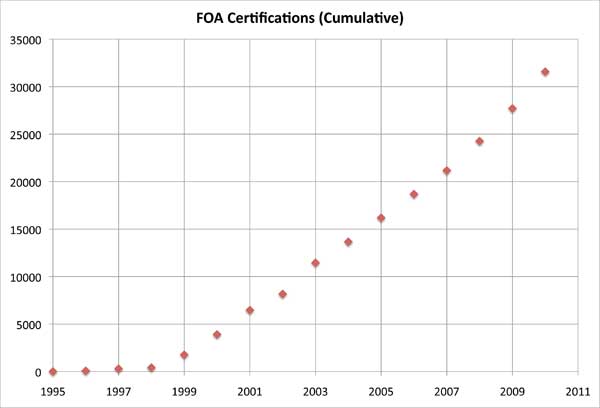 This means that fiber continues to grow in importance in the communications world, that FOA certifications are being recognized worldwide and techs depend on the FOA for learning about fiber optic technology, either directly from our educational materials or from one of our >200 FOA Approved trainers. In the coming year, the FOA will continue to develop educational materials that keep fiber optic techs up to date on the latest technologies, component developments and installation processes to ensure they are able to cope with the fast development of fiber optic applications. Where do we see fiber's strongest growth? Municipal systems for security and communications, fiber to wireless towers and all the way up to the antennas, cabling for 10G and above in data centers and, of course, providing the infrastructure for broadband to the home. The FOA will add some new tricks in 2011 to help techs in their jobs. We're starting a new online lecture series on YouTube. We'll be expanding our self-study programs, including adding a fiber optic design online program. perhaps leading to FOA specialist certification. We will provide free Apps for the iPad and iPhone to help techs by automating the calculation of loss budgets for their systems, converting fiber optic power measurements and other installation aids. We'll even offer an App that will be a self-study program based on our textbooks. We'll continue to focus our efforts on supporting our schools, our members and the entire fiber optic industry to ensure its continued success. Jim Hayes President Testing by CCCA Finds High Failure Rate in Imported Cat 6 Copper Patch Cords The Communications Cable and Connectivity Association (CCCA) announced that it recently completed large-scale, electrical performance testing of Category 6 copper patch cords. Test results show an 85% failure rate in patch cords produced offshore by companies who are largely unknown in North America. A second, large sample set of Category 6 copper patch cords produced by multiple, well-recognized manufacturers was also tested and showed 0% failure rate. Here is the full report. Editorial comment: In a article published 8 years ago, we expressed similar concerns about UTP patchcords and 6 years ago, we first encountered fiber optic patchcords that had labels indicating test results that were far better than actual results when tested properly. Just recently, we were sent a sample of a patchcord, also with a label indicating good test results, that had a ST connector which had a bayonet locking nut missing one slot for a latching pin! That patchcord could not have been tested because it could not be inserted in a mating adapter. 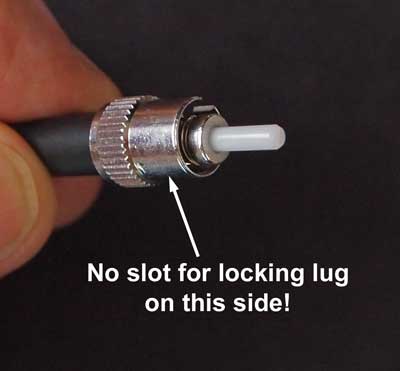 We know there are good producers of fiber optic components around the world, but there are also some really bad ones. Buying critical items like patchcords by price alone may not be a good practice. The wise user knows the source of the products they buy and they inspect the components they receive to ensure they are getting good quality. JH How To Manage Cables In A Patch Panel - NOT! 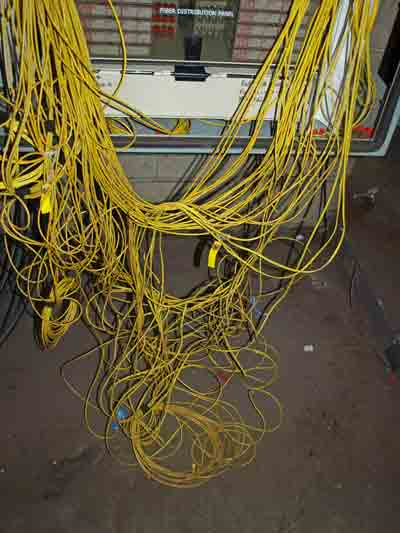 (thanks to one of our readers who for obvious reasons prefers to remain unnamed!) Interested in Decorative Fiber Optic Lighting? 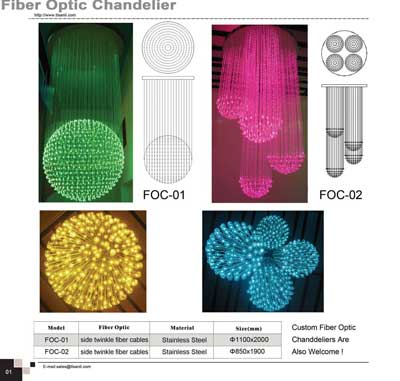 These cool fiber optic chandeliers come from TLSANLI in China. For more information, see http://www.tlsanli.com/index.html# Way Back When.... 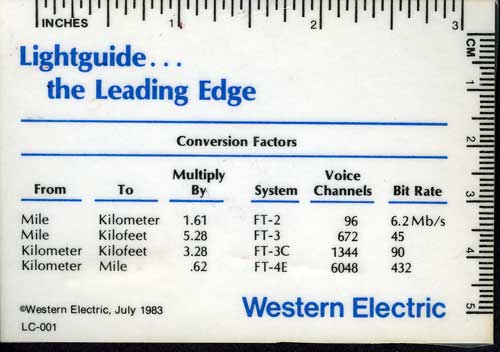 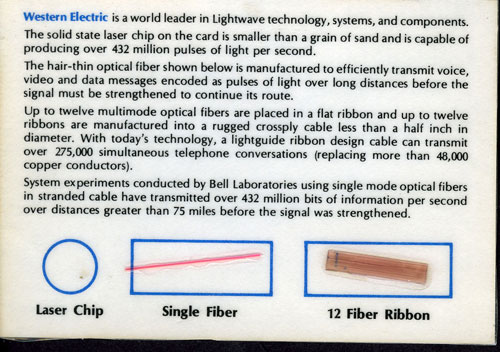 This was an AT&T handout during trade shows almost 28 years ago (it's dated July 1983) to illustrate their technology in fiber. Note the laser chip and the ribbon fiber (below). It's noted in the text that the ribbon is multimode fiber and singlemode fiber is mentioned in experiments only! This is at least a year before singlemode became commercially viable. 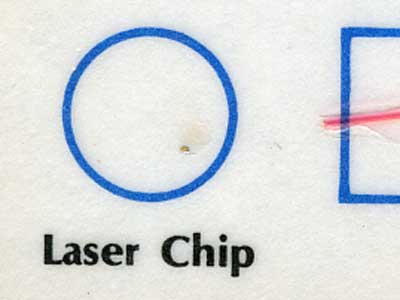 NECA/FOA 301 Installation Revised 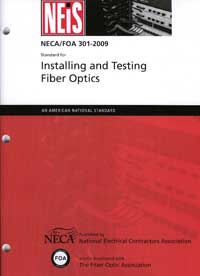 The FOA NECA 301 standard on installation of optical fiber systems has been revised for the second time, adding considerable new materials. This standard is derived from FOA educational material put in standards form and approved by ANSI as an American National Standard. It's specifically written to be used in contracts to define "installation in a neat and workmanlike manner." The standard is available from NECA. FOA Begins New Lecture Series on The FOA is dedicated to make technical material readily available to all those interested in fiber optics. For all 15 years of our existence, we've created reference materials in the form of printed textbooks and web pages. Now our Online Reference Guide has grown so large it needs it's own Google Search and we offer all three of our new books on the Amazon Kindle or Apple iPad/iPhone/iPod. Recently we started our own channel on YouTube and the response has been enthusiastic. So we've been adding more videos to YouTube, including a demonstration of how to use your cell phone camera to detect IR light in fiber systems and have started a lecture series on fiber optics. The first lecture is called "Fiber Optics and Communications" and FOA President Jim Hayes describes the many different uses of fiber in telecommunications, CATV, security, utility and many other networks. Lecture #2 is all about safety in handling and installing fiber. Future lectures will cover the basics of fiber and cable, termination and splicing, installation and testing. Subscribe to the FOA Events of Interest  OFC/NFOEC is the world's leading global conference and exposition for optical communications and networking professionals. Technical Conference March 6-10, 2011 • Exposition March 8-10, 2011, Los Angeles Convention Center, Los Angeles, CA, USA. More. Free Corning "See the Light" Seminars Corning is offering free 3 hour seminars on "Termination Technology" in over a dozen cities around the US in the coming months. The seminars focus on new termination techniques and will give attendees real hands-on training. You must pre-register for the seminars, and we recommend you do so soon as they will probably fill up quickly! February 16 Phoenix, AZRegister at http://registration.corning.com/1STL%2D2011/ Utility Products Conference & Exposition  The Utility Products Conference & Exposition brings the pages of Utility Products magazine to life and brings together buyers and sellers of power, telecom, CATV and water equipment - including fiber optics, providing them an opportunity to learn firsthand about their industries’ latest products. Click here for more information. Webinar: The Future of Mobile Backhaul: Are You Ready?  TIA invites you to a preview webinar on the role of Mobile Backhaul in meeting demands of the proliferating wireless devices hitting the marketplace. The webinar, being held January 26, 2011 at 11 am EST, is sponsored by Walker and Associates. TIA FULL FREE WEBINAR SERIES - Register now on the TIA 2011 Digital Marketplace site. Exploding use of smartphones and tablet devices is driving huge access network bandwidths. At the same time, users are demanding high quality, low delay voice and video services with ubiquitous coverage. We know what the solution is - fiber backhaul of course! Broadband Properties Webinar Archives  Lots of interesting webinars, mostly on FTTH. Go here. Two New Free Fiber U Self-Study Programs on OSP and OTDRs There are two new free online self-study programs on Fiber U. "Outside Plant Fiber Optics" uses the new FOA textbook and online reference guide to OSP to help you learn about OSP fiber networks. The "Understanding OTDRs" self-study program will help you learn how to properly use these complicated instruments and there is a free OTDR simulator you can download to use for practice. FOA Certification On Outside Plant Fiber Optics The new FOA CFospT outside plant certification focuses on OSP fiber optic network design, installation and maintentance. A CFospT certified tech must know the ways that fiber is used in the OSP, how it is installed, tested and maintained. While a CFOT might only have a basic knowlede of fusion splicing and OTDR testing, for example, a CFospT will be knowledgeable and skillful in those areas - and more. Reference materials for the new CFospT are the printed textbook, the FOA Reference Guide to Outside Plant Fiber Optics (right) as well as eBooks from Amazon for the Kindle or Apple for the iPad/iPod/iPhone and the OSP reference section of the FOA Online Reference Guide which now includes a self-study guide to the CFospT exam. More information on the FOA Outside Plant Fiber Optic Technician (CFospT) certification. Want to know more about OSP? There's OSP Magazine for that - and a trade show, OSPExpo, running this fall in San Antonio.
   We have created three new FOA books to be used in training for FOA certifications and as reference books for contractors, installers and end users of fiber optics. These books have full curriculum support, including free curriculum materials for teaching FOA certification courses. Because we are self-publishing these books using more modern "publish on demand" technology, they are easier to keep up to date, easier to buy and much, MUCH cheaper! All are now available in print and electronically in Kindle and Apple iBook versions. Details on the new book each of the new books are at the book pages linked to the photos above. FOA Online Fiber Optic Reference Guide Basic Fiber Design Section Updated Lots of new materials added to this introduction to fiber optic design. New Web Page on Data Centers Data centers are the heart of the Internet, storing and supplying data for user requests. Needless to say, high performance cabling is needed to move the data between storage, servers and routers. We've created a new pagein our Online Reference Guide on data centers - how fiber and cabling are vital to their performance. Learn More About OTDRs - Download a Free OTDR Simulator More and more installers are being asked for OTDR testing but using these instruments is not easy. They are hard to set up properly and complicated to interpret the traces. Using the autotest function can lead to disastrous results! The FOA has a good tutorial on OTDRs on our Online Reference Guide and we added a free download of an OTDR simulator to the OTDR section so you can learn how to use an OTDR on your PC. New OSP Reference Section on the FOA Online Reference Guide website Joining our basic fiber optics and premises cabling sections on the FOA Reference Guide website is a new outside plant reference section that covers materials like that in our new textbook. The material is ready for use and will be followed shortly by a self-study guide. Both the OSP textbook and website are references for the new FOA CFospT outside plant technician certification, due this fall. More New Info: Data centers - how fiber and cabling are vital to the performance of data centers. FOA Videos Now on Links to manufacturers and distributors of fiber optic lighting products. In "Testing" we added a free download of an OTDR simulator to the OTDR section so you can learn how to use an OTDR on your PC. The FOA Online Fiber Optic Reference Guide has become very popular - perhaps the most popular technical website ever, typically with over 30,000 users downloading about 1/4 million pages monthly! We continue updating materials regularly, keeping it as up to date as possible. Just this month, we added a page on "polarity" for fiber optic networks. Although it seems obvious that connecting transmitters to receivers is required, how it's accomplished can be confusing! We already updated the Premises Cabling sections in conjunction with publishing the FOA Premises Textbook and are now focused on outside plant applications (OSP) with a new OSP reference section. We've already added a new page on chromatic dispersion (CD) and polarization-mode dispersion (PMD). Find What You Want Using "Google Custom Search  There's
so much information on the FOA Tech
Topics and Online Fiber Optic Reference Guide
that even a well-organized Table of Contents isn't enough and when the
material is always changing, an index is impossible to maintain. So the
FOA is using the latest technology in search, Google Custom Search,
which will allow you to search just the
FOA Tech
Topics and Online Fiber Optic Reference Guide for
any topic you want to find more about. Try
it! There's
so much information on the FOA Tech
Topics and Online Fiber Optic Reference Guide
that even a well-organized Table of Contents isn't enough and when the
material is always changing, an index is impossible to maintain. So the
FOA is using the latest technology in search, Google Custom Search,
which will allow you to search just the
FOA Tech
Topics and Online Fiber Optic Reference Guide for
any topic you want to find more about. Try
it! Go to The FOA Online Fiber Optic Reference Guide. School News Want to Own The Best School in Canada? Mississauga Training Consultants is looking for a new owner. This 15 year old company is a great opportunity for someone who has fiber experience and likes to teach. Also a great way for a current school to establish a presence in Canada. William will work with the new owner for up to six months to help them get established and grow. If there is not a new owner by April I will consider breaking the company up and selling it in pieces. The web site www.fiberoptictraining.com has top rating. William Graham, CFOS/S/T/C/D/, CFOI Mississauga Training Consultants email: mr.bill.graham@sympatico.ca www.fiberoptictraining.com Tel: 905-785-8012 Cell: 416-659-8713 Featured School - New FOA Courses in UK BDI DataLynk, which offers fiber optic courses around the US in partnership with colleges, will offer FOA Sanctioned Fiber Optics Courses in the UK starting January 2011. Mr. John Tait has become the BDI Datalynk Instructor Partner and will be teaching all courses starting 26th January 2011. John has worked in the fibre optics industry for 35 years and has been involved in fibre optic cable manufacturing and distribution both in the United States and the UK. Over the last 25 years he has provided training in fibre optic technology to people in many countries around the World. John holds a Masters Degree in Physics from London. The FOA-BDI Datalynk course location is: West Kent College Brook Street, Tonbridge, Kent. TN9 2PW | Tel: 01732 358101 http://www.wkc.ac.uk/ CFOT - 24th January to 26th January, 2011 CFOS/T - 27th January to 28th January, 2011 CFOS/S - 31st January and 1 st of February, 2011 Please direct all questions regarding the course to: Mr. John Tait via email at: tait731@btinternet.com or see http://www.kentbusinesstraining.co.uk/courses/it-for-business.html We are happy to welcome Mr. Tait on board and appreciate the opportunity to add West Kent to our training course list. Find a listing of all the FOA-Approved schools here. It's Now A Lot Easier To Find A FOA-Approved Training Organization 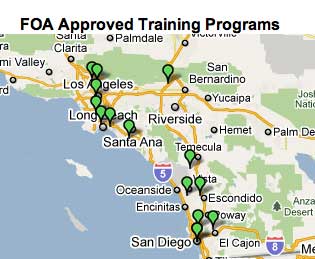 Most phone calls we get regarding finding a FOA-Approved training organization want to know two things: what school is closest to me or what school offers the certifications I need. That can be difficult, since the FOA has almost 200 training organizations we have approved worldwide! We've been looking at ways to make it easier, and we think we've got a good solution. In fact we have two solutions. First we have added a sortable table of all the FOA-Approved schools. You can also use our FOA Google Map Application to find FOA-Approved schools. Here are links to the sortable table of all the FOA-Approved schools and FOA Google Map. What Should A Fiber Optics or Cabling Tech Know and What Skills Do They Need? The FOA has been updating its lists of KSAs (Knowledge, Skills, Abilities) for fiber and cabling techs. The updated list is now on the website for your information and comments - as fiber and cabling KSAs evolve as new technologies develop. KSAs for fiber and cabling techs. Good Question! Tech Questions Worth Repeating Tech Hint: Did You Know You Have A Fiber Optic Tester In Your Pocket? Yes! The camera in your cell phone is sensitive to infrared light - lots more than your eye - and can detect light in an optical fiber or from a transmitter. Chris Hillyer,CFOT/CFOS/I, Master Instructor, Northern California Sound & Communication JATC sent us some photos showing how this works. See below or the video now on YouTube. Cable Plant Documentation Programs Q: We provide design and engineering for the telecommunications industry, including fiber optic design. We are looking for a computer application or customized database for fiber optic documentation. Can you point me in the right direction? A: We know of no pure FO documentation programs today - although we created one when we were in the manufacturing business about 20 years ago that died for lack of interest. Bellcore/Telcordia used to offer one but I do not know if it's still available. It was horribly expensive - designed for the telcos. We know people who use spreadsheets and CAD programs they developed themselves. Companies offering bidding programs for electrical contractors (Accubid, McCormick Systems, etc.) have added fiber and structured cabling to their programs and may have something you can use. More on Loss Budgets Q: Reading your tech article labeled lossbudg.htm, I think there are some redundant losses calculated. You show a setup with a TX connected through other connectors (patch panel) a splice another patch panel and connected to a receiver. You state that you consider all of the connectors to have loss, including the connectors at each end. I question this concept. When a fiber optic transmitter states the output power parameter, say -20dBm launched into 62.5/125 fiber optic cable, it already takes the connection to the transmitter into consideration. The fiber, once connected to the transmitter should be receiving -20dBm of light power. The same situation exist at the receive end. The receiver states that it has a maximum sensitivity of -32dBm, from a 62.5/125 fiber optic cable. The only way to measure this is to connect a fiber optic cable to the receiver and vary the power to determine the lowest level at which the receiver will operate then measure the light out of the fiber cable. This connector is part of the measurement and should not be used as part of the power budget calculation. I submit that the only elements to be considered in calculating power loss are the patch panel(s), splices, and fiber cable attenuation. If a TX states minimum power launch is -20dBm and the receiver states maximum sensitivity is -32dBm then this pair of equipment has an optical budget of 12dB. One should expect that when they connect the patch cable to the TX it will launch -20dBm and when they connect the patch cable to the RX it will launch all of the light exiting the fiber optic cable onto the RX. The only elements that can cause attenuation are those elements between the TX and RX connectors. A: The concept of the loss budget has two viewpoints: 1) The systems people need to know how much cable plant loss their transmitters and receivers can tolerate and 2)The fiber designers/installers need to know if their cable plant will support the communications system that is supposed to use the cable plant they install. Both need to know that the connections at the equipment couple the proper amount of light into the fiber from the transmitter source and transmit the proper amount to the receiver detector as well as the intermediate losses are within reason. The coupling at either end will only happen if the connectors on the ends of the cable are low loss. The cable plant designers and installers generally do not have the equipment onsite to use to test connectors for proper coupling to transceivers, but they do have the test equipment to test the connectors against another known good reference connector. Systems people who test their equipment for coupled power, however, do have the ability to test their products with known good connectors, so their coupled power numbers assume a certain performance level, e.g. low insertion loss, from the connectors used for the coupling. This line of logic has led us to have a convention of including the connections on the end of the cable plant in the loss budget. In the early days of fiber optic standards, there were some strays! IBM once used a 3-cable reference for their systems because they came to the same conclusion that you did and the 3-cable reference reduced the measured loss by two connector losses, making them think they had made the proper compensation. But the logic proved wrong (see http://www.thefoa.org/tech/ref/testing/5ways/lossmath.html) and they realized the 3-cable reference had a higher measurement uncertainty (see http://www.thefoa.org/tech/ref/testing/5ways/fiveways.html toward the end). Now by convention, when the systems people specify a power budget, they generally use the testing standards which include the connectors at the end, and I believe this is true for all standardized networks. So the method we specify works for both systems and cable plant analysis and is the accepted version. Have you ever tried to test coupled power with known bad or dirty connectors? It's an interesting experiment! And some transceiver's couplings are very different with 62.5/125 and 50/125 fiber. There are also test standards for coupled power and they specify using cables with tested connectors of low loss. Loss Values in TIA Standards Q: I have read the information about fiber optic test on the thefoa.org website. I also noticed that the TIA 568-C.3 Standard already came out. So does the 568-C.3 standard has different attenuation, connector loss and fusion splice loss than the 568-B.3? I am trying to establish the fiber installation standard for our plant, but I still new to fiber optics. A: The issue of what attenuation or loss values for components is under review at this time, but the current numbers are the same as before. The most contentious issue is connector loss, since 0.75 dB was chosen a long time ago to allow the inclusion of prepolished/splice connectors, which at the time were pretty awful! Today PPS connectors are better, around 0.5 dB max, and there is a recognition that the value needs updating since some 10G and faster networks will not work with more than 2 connections on the end using the 0.75 dB connector loss. But there are members of the TIA committee who do not want to change the values for various reasons. Internationally, they use a statistical method which is somewhat confusing! Splicing Q: I am splicing SC/UPC pigtails, about 6 meter, with single-mode fiber. My splices have always seemed good; I hit them with an OTDR and I barely see them, if at all most of the time. However, I was just using the VFL to check for macro bends, etc. and I am seeing a little bit of red light at my splice. The funny thing is, right after my splice, I see nothing….then after a minute or so I see the light emitting from the splice. Can you shed some ‘light’ on this for me? Is it normal to potentially see a little light escaping at the splice? A: What kind of splice protector are you using? If its a heat shrink type, it may be causing stress as it cools. We've seen that in connectors also. 10 Gigabit Link Deployment Q: I have laid and terminated a standard singlemode fiber cable of less than 1kilometer to service 10gig link. I have deployed X2-10GB-LR module on the switch ports but it has not responded. Do you have troubleshooting ideas? A: First, we assume you have tested the insertion loss of the link and it is within specifications. At 1300 nm, it should be ~0.4 dB for the fiber, plus connector and splice losses, and if continuous with no splices or intermediate interconnects, it should be ~ 1 dB. If that is the case, there are two potential issues: 1. Too much power at the receiver. Most of these links can operate over 6-11 dB (http://www.thefoa.org/tech/Linkspec.htm) so a 1 dB link may lead to overload at the receiver. This requires a inline attenuator at the receiver. Measure the power at the receiver and if too high, use a fixed attenuator to bring it to the right level for the receiver. You can also make a temporary attenuator with a SM patchcord would tightly around a pencil! See http://www.thefoa.org/tech/ref/appln/attenuators.html 2. Multipath interference. The reflectance of connectors at the end of short lengths like this can bounce back and forth in the link, causing noise. Remember the reflected signals would only be attenuated by 2 dB in a round trip on the fiber. If the connectors are UPC (ultra PC) or APC and in good condition, this will be less of a problem. Fiber Backhaul Instead of Microwave for Wireless Q: I am in a small remote alpine town creating a case to have fiber optic backhaul instead of the beleaguered microwave link currently provided by the iLEC. Could you please point me in the direction of any materials that would empirically support the advantages of fiber backhaul for remote sites vs the dis-advantages of microwave links. The microwave system we're trying to get the iLEC to replace spans about 35miles per hop, and "supports" three DS3 equivalent circuits; but real world performance is pretty poor from the end user's perspective. Since the town is fed with DSLAMs, it's tough to really load the link until all the tourists are here making cell calls, using mobile data, and occupying the residences & hotels -then the link really maxes out. If we have a busy weekend, and get 48" of snow over night - same thing - delay, jitter, congestions of the available path. A: Microwave has been used in many areas where fiber is hard to install, like mountains, but with the advent of 4G systems carrying lots of data and video, microwave is giving way to fiber backhaul. In fact, one of the biggest areas for fiber expansion today - plus they are using it to connect the antennas on the tower. Try this: http://connectedplanetonline.com/images/CP_ADC2_WhitePaper.pdf Buried Cable Depths Q: What is the proper depth to bury underground cables? A: We've researched this for our latest book on OSP fiber (http://www.thefoa.org/FOArgOSP.html) and can share with you our findings. The most widely used "rule of thumb" is bury fiber 3-4 feet (1-1.2m) deep, with a ton of exceptions. In suburban areas where cables are grouped and marked and backhoes are less likely to dig up cables, it's not uncommon to bury cables 18-24 inches (~0.5m) deep. In areas with "cable congestion," like Boston during the "big dig" cables were at all depths - many much deeper. In cold climates, freezing water in conduit can be an issue and cable manufacturers are capable of supplying special cables for these installations. About 15 years ago, we worked with a project to test fiber at the Scott-Amundsen base in Antarctica where fiber optic cables were run aerially, direct buried and run in conduit with no problems. Although I've been in MN in mid-winter and thought it was like Antarctica, I thing the real place is probably worse! Our answer, then, is shallower depths are OK as long as the cable is chosen appropriately for the installation. Fiber Cleaning This is a topic we keep reminding everybody about, and here is why: From a contrator in the Middle East: Here some samples of the connectors for SM fiber already installed in the system we were testing. 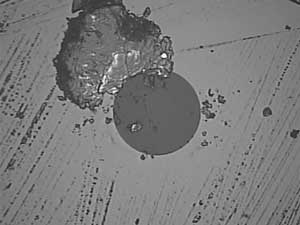 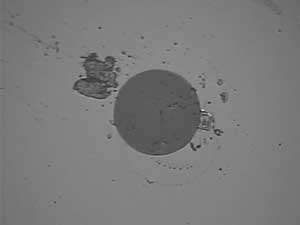 As you can see, the dirt is large compared to the size of the fiber (dark gray), and the core (not visible here) is only 9/125 of the overall diameter of the fiber! See Product News below for links to vendors of fiber cleaning products. Measurement Uncertainty: Everyone testing fiber optics should understand that every measurement has some uncertainty - whether you are measuring loss, length, wavelength, power, etc. Knowing that uncertainty is very important to interpreting the measurement. It's worthwhile to read and understand the issue of measurement accuracy covered in this page of the FOA Online Fiber Optic Reference Guide. Worth Reading: Electricity and Light in One Chip Silicon chips with both optical and electrical circuits could eliminate a bottleneck limiting supercomputer speeds. MIT Technology Review Underground sensors could change border enforcement It doesn't involve cameras or fences or enforcement agents. It involves cable. Fiber optic cable, specifically, that is buried a short distance below the ground and can sense exactly what's going on up above. NPR Marketplace Light scattered via nanotubes Just as walkie-talkies transmit and receive radio waves, carbon nanotubes can transmit and receive light at the nanoscale. The principles that govern the interactions between light and the carbon nanotube are the same as between the radio antenna and the radio signal, not like geometric optics in fiber. Futurity Does The Brain Communicate Over Fiber Optics? The Puzzling Role Of Biophotons In The Brain: Various work suggests that neurons emit and even conduct photons. Could it be that biophotons help to synchronise the brain? MIT Technology Review Ensuring Distance Accuracy On OTDR Measurements By JDSU. 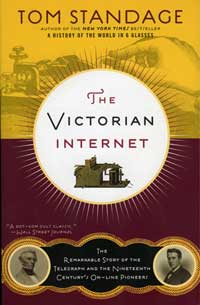 If you think the Internet has changed communications in recent years, consider the effects of the introduction of telegraphy 150 years ago. Communications went from as slow as horses, ships or trains could carry news to instantaneous! Who was the first to use it? Stock traders, of course, and low latency is still their goal! It's a good read, and you'll find out some new info on Thomas Edison! On Amazon. Broadband Properties Webinar Archives  Lots of interesting webinars, mostly on FTTH. Go here. FTTX Networks An ADC white paper on how they work and how networks are upgraded to FTTH. http://connectedplanetonline.com/images/CP-ADC3-WhitePaper-v4.pdf. JDSU Application Note On "Qualifying FTTH Network before Equipment Installation" Another great paper from JDSU covering FTTH PON networks is available for downloading. It gives an overview of FTTH architecture, cleaning connectors then testing the cable plant with OTDRs and OLTSs. This paper will help you understand why OTDRs can be confusing on PONs! Best Practices For Wireless Backhaul Network Upgrades Joan Engebretson, Contributing Editor of Connected Planet has written a very good overview of how fiber is essential to the operation of cellular wireless systems. Everybody probably knows that fiber is used to connect towers into the telecom network - they call it backhaul - but her article also covers the new appliations to replace bulky, heavy, lossy coax up the tower to the antennas. http://connectedplanetonline.com/images/CP_ADC2_WhitePaper.pdf. Fiber Optic Safety Poster We've had numerous requests to reprint our guidelines on safety when working with fiber optics, so we have created a "Safety Poster" for you to print and post in your classroom, worksite, etc. We suggest giving a copy to every student and installer. Corning now offers videos on  .
Lots of interesting videos, some technical, some sales, but all good
information. .
Lots of interesting videos, some technical, some sales, but all good
information.US Conec's videos on cleaning fibers - show's the results of proper cleaning. Webinars of Interest Broadcast Engineering Magazine - Fiber Optic Testing FOA President Jim Hayes presents an overview of fiber optic testing for all applications. Available on Demand. Sign up here. Multimode Fiber Trends from TIA's Fiber Optics LAN Section Ryan Chappell, Draka Communications, looks at the evolution of multimode fiber, examines its current usage and shares predictionson its future Available on-demand at: http://www.brighttalk.com/webcast/7182/play OSP Magazine Webinars OSP Magazine (OSP as in outside plant telco) is now offering a number of interesting webinars that cover fiber topics, including network design and specialized components. http://www.ospmag.com/events/web/ Multimode Fiber Characterization Launch Condition Considerations - new ap note from JDSU JDSU Reference Guide to Fiber Optic Testing – Volume 2 Published  The second volume of the JDSU series on fiber optic testing has been published. Volume 1 focused on Basic Fiber testing and Volume 2 is geared toward fiber optic installers, project managers, telecom technicians and engineers who need to understand fiber networks. Volume 2 also covers Chromatic Dispersion, Polarization Mode Dispersion, Attenuation Profile and Fiber Link and Network Characterization. A 3rd volume, a glossary of fiber optic terms, is also available for download. This is a "MUST HAVE" for all fiber optic techs. Download your free copies here. We used this book as one of our references in creating a new page in the FOA Online Reference Guide on chromatic dispersion (CD) and polarization-mode dispersion (PMD). Careers in Fiber Optics: Brian Smith. A 1998 book on fiber optic jobs is a bit dated, but a free overview is on Google Books and worth a look at it online. Dirt! As much as 70% of the problems associated with deploying fiber to the home result from something as simple as dirty connectors according to JDSU. Telephony Online. US Conec's videos on cleaning fibers - show's the results of proper cleaning. Good Technical Websites American Polywater (http://www.polywater.com/) has one of the best technical website for cable installers. Here is a rundown on some new material on their site. Cable Installation using "Push" or "Push/Pull" Polywater's new Pull-Planner™ 3000 Software allows a "pushing force" variable in pulling tension calculations. Read a White Paper that quantifies the push contribution and compares calculation results to field experience. -- http://www.polywater.com/pushing.pdf Pulling Cable Through Water? Read a Product Spotlight on Polywater® + Silicone™, Polywater's new generation underground lubricant. Continued reduction of friction when pulling through water is only one of the unique features of this lubricant. -- http://www.polywater.com/NNNBSL.pdf Check out their website, especially “Videos,” “Engineer’s Corner” and “Calculators.” http://www.polywater.com/NNNBSL.pdf  " Heard on the Street" is a monthly online newsletter from Frank Bisbee of Communications Planning Corporation that covers the telecommunications and cabling businesses. Each month includes news from manufacturers, trade associations and professional societies like the FOA. You can read the current issue and back issues online.  JDSU has announced the See the Light webinar series, a four-part program designed for anyone involved in the installation, maintenance, and repair of fiber optic systems. It begins with fiber inspection and cleaning and then covers the basics of fiber testing. The webinar series then continues with the more advanced optical time-domain reflectometer (OTDR) and fiber local area network (LAN) testing challenges. More information on the series. IGI is offering a series of webinars on topics of interest to those in the communications industry. You can join them live ir download from the archives. IGI WEBINAR ARCHIVES UP AND RUNNING - VISIT TELECOMBRIEFINGS.COM TO DOWNLOAD! IGI, a major market research and technology reporting company (the "Active Optical Cables" below) is offering a a free one year subscription to one of our fiber optics newsletters to FOA members. All they have to do is to send IGI an e-mail stating which newsletter they would like to get. See http://www.igigroup.com/nl.html for a listing of IGI Newsletters. A Fiber Optic Tester In Your Pocket? (See the video on Yes! The camera in your cell phone is sensitive to infrared light - lots more than your eye - and can detect light in an optical fiber or from a transmitter. Chris Hillyer,CFOT/CFOS/I, Master Instructor, Northern California Sound & Communication JATC sent us some photos showing how this works and the following description. 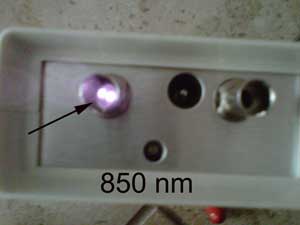 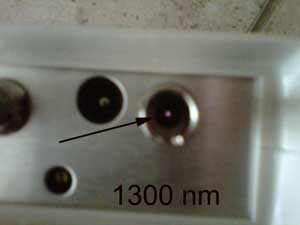 "Your cell phone camera's image sensor can read IR light. It uses this technology to help take pictures at night. In the advanced audio and CCTV field they have been using the smart phone camera to trouble shoot problems in IR communications. The human eye cannot see the IR light emitted by let’s say a remote control. Well up until now we would always say that the remote is out of batteries, or either the IR transmitter or IR receiver was not working properly. Now we can use your smart phone camera to see the IR light emitted by the IR transmitter. All you have to do is turn on your camera function on your smart phone and hold it up the remote control and push any button. The cameras screen will show the IR light. Now back to Fiber Optics. If you follow the same principals of the last paragraph, let’s say you wanted to check if a fiber port was energized. You can either use the card that is supposed to show you in a few seconds that the port was hot. Or you could plug in your meter, in this case it takes some time to find the card or if you don’t have your meter handy. Just pull out your smart phone turn on the camera and hold it over the port. If it is hot you will see a bluish white dot in the fiber bulk head (see attached pictures)." We tried this ourselves and found our camera phone very sensitive at 850 nm but as expected less so at 1300 nm, like all semiconductor detectors. Our phone could still see 1300 nm sources at around -20 dBm, making it very useful even for LED sources, and of course, perfect for lasers. OFSTP-14 Update OFSTP-14 is the TIA standard for testing installed multimode fiber optic cable plants which has been around more than 20 years and is the one TIA standard probably most familiar to contractors and installers. The TIA has adopted IEC 61280-4-1 as the replacement of OFSTP-14. Most of the two documents is the same, with some important exceptions.
We are creating a web page to explain the differences and will give you a link shortly. In the meantime, continue testing as usual. The FOA reference website is now online. New sections have been added on Outside Plant Fiber Optics, fusion splicing and mechanical splicing. Check out the current Table of Contents. This month, we added a page on "polarity" for fiber optic networks.
AFL Offers Neat Solution For Prepolished Connectors Prepolished connectors have gotten much better recently as manufacturers move to using quality cleavers for fiber preparation and VFLs to verify a proper splice termination. Corning has incorporated these into their Pretium kits with a VFL and GO/NOGO indicator in the termination tool. Now AFL has another solution. On their FAST connectors, they have a clip that functions as an indicator for the VFL and the crimp tool for the fiber. Watch this video for a better explanation. A Cable Tie That's Fiber Friendly We're always warning installers not to tighten cable ties too tightly around fiber optic cable (or UTP copper cable either!) A better choice is the hook and loop fastener ties (Velcro is one trade name), but there is another type, the Mille-Tie. It's an open tie that can be used at any length, then cut off and the remainder used also. Take a look a the video to see how it works. Mille-Tie Video: http://www.youtube.com/watch?v=QPVTQGKmcvE See the Corning Web Pages On BI Fiber for more details. Corning ClearCurve® multimode optical fiber combines the high bandwidth performance of laser optimized fiber types, e.g. Corning InfiniCor® SXi (OM2), InfiniCor®SX+ (OM3) and InfiniCor® eSX+ (OM4) fibers, with advanced macrobending performance. ClearCurve® multimode is specifically designed for Enterprise networking applications such as LAN (local area network), SAN (storage area network), campus networks and Data Centres. All Corning ClearCurve multimode fibers are able to support transmission speeds of 10/100 Mb/s through to 10Gb/s and are ready for next generation speeds of up to 16/40/100 Gb/s. • ClearCurve OM2, OM3 and OM4 multimode fibers are compliant and fully backwards compatible with all relevant industry standards;
multimode installed base
• ClearCurve multimode fiber may be spliced or connectorized to conventional 50/125 fiber types with commercially available equipment and established practices and methods; no special tools or procedures are required. Testing has been done with Corning fibers and various competitive standard and bend insensitive fibers and no issues were observed. Corning has stated that all their MM fiber will be BI fiber and has created an app note on how to implement the TIA-spec mandrel wrap with this fiber. Here is the complete information reported in the FOA April Newsletter. AFL Launches Fiber Security™ Perimeter Intrusion Detection System New system incorporates fiber optic sensing cable and vibration sensor unit 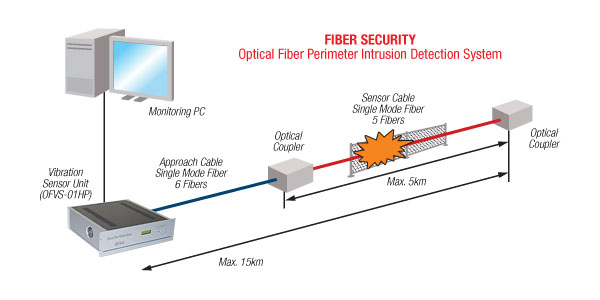 AFL announces the release of its optical fiber perimeter intrusion detection system, Fiber Security. While new to the US market, this system has been deployed more than 40 times in Japan and Canada by AFL's parent company, Fujikura Ltd. Fiber Security utilizes a fence-mounted fiber optic cable coupled to a sensing unit that analyzes the magnitude and pattern of vibrations at the fence. The sensing unit's unique algorithm is capable of discerning high and low level vibrations and filtering out vibrations not associated with intrusions. Up to 100 individual zones can be set up using the software, and the individual zones can have different levels of sensitivity as needed. Detection accuracy is +/- 2% over the entire sensing length of the perimeter, up to 3.1 miles in length while operating up to 6.2 miles from the sensing unit. No power is required in the field with only standard 110V power necessary at the sensing unit and PC. A user-friendly graphical interface depicts the property and the perimeter giving visual representation of where an intrusion is detected. AFL's Fiber Security is highly successful at detecting multiple intrusion events such as climbing, cutting, or lifting a fence. Environmental noise such as traffic, trains, or planes, and wind and rain are actively filtered out by the algorithm to reduce false positives while maintaining sensitivity. The system can be integrated with video systems and other technologies such as passive IR sensors via Ethernet, dry contactors, or RS232 connections. Fiber Security can send remote alerts via e-mail for facilities that do not have full time personnel on site. Highly dependable laser diodes coupled with a completely passive optical sensor translate to low maintenance costs over long periods of operation. With the ability to function as a standalone system or as part of an integrated security solution, AFL's Fiber Security is now available to meet your perimeter intrusion detection needs. For additional information, visit www.AFLtele.com/go/FiberSecurity. Benchtop Connector Cleaner 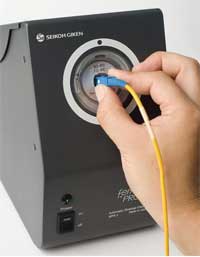 FerrulePro™ is the world’s first fully automated benchtop fiber connector cleaner for laboratory and cable production environments. It automates the final cleaning of all types of terminated fiber products, a critical task where performance once depended largely on the production line worker’s skill. Fiber connectors can be cleaned in 3 seconds cycle - eliminating the need for re-cleaning after post production inspection. More. End-Of Summer Sale on FO Toolkits at TTTP Save 25-40% off Advanced Fiber Solutions fiber optic installation toolboxes with test equipment. Go here. New AFL Cleaver Does Regular and Angle Cleaves Both cleavers incorporate an easily replaceable blade and cleave 250µm and 900µm fibers. They are easy to use, simple to adjust and extremely consistent. More details. Draka Expands Bend-Insensitive Fiber Line A large number of Draka fibers are available with BendBright-Elite fiber. In North America, BendBright-Elite is available in premises and outside plant cables. Draka introduced the BendBright family of bend insensitive fibers in 2002 and has since expanded the product family to four versions of bend insensitive fiber, spanning both singlemode and multimode types:
But it means changes in the way you test with it! Corning announced that effective April 1, 2010, ClearCurve® multimode optical fiber will become its standard 50-micron multimode fiber product offering. "ClearCurve multimode fiber is the world’s first laser-optimized, high-bandwidth, multimode fiber to withstand tight bends at 7.5 mm radius with substantially less signal loss than traditional multimode fibers. ClearCurve multimode optical fiber was first introduced by Corning in Jan. 2009 and has been validated through broad customer acceptance of the product. Traditionally, when an optical cable experiences tight bends, some of the light can escape from the fiber core and part of the signal can be lost. Corning ClearCurve multimode fiber is designed to keep the light in the fiber core, even under tight bends, and better maintain the integrity of the optical fiber signal. “Corning’s 50-micron multimode fiber customers will now benefit from superior bend performance. This will result in faster and more efficient optical cable routing and installation, and significantly higher spare operating margin, at no additional cost,” said Martin J. Curran, senior vice president and general manager, Corning Optical Fiber. Corning ClearCurve multimode fiber meets or exceeds the OM2, OM3 and OM4 industry standards for high-bandwidth, laser-optimized multimode fiber. Corning will demonstrate the performance of ClearCurve multimode optical fiber from March 23-25, 2010, at OFC/NFOEC in San Diego. Detailed product specifications are available at www.corning.com/clearcurve." When You Test... Most standards call for a "mandrel wrap" mode conditioner on your launch cable. The Corning announcement made us wonder what happens with this bend-insensitive fiber if you wrap it around a standard mandrel - it should not act the same as regular 50/125 fiber. We contacted our friend the Marketing Manager for the product at Corning and he confirmed our suspicions. The difference in the bend sensitivity of the fiber requires a much smaller mandrel, only 6 mm in diameter, to have the same effect. This is detailed in Corning Application Engineering Note "Multimode Fiber Considerations for Test Jumpers, AEN 131, Revision 2" available from Corning. Add OCC to the list of cable manufacturers offering "bend-tolerant" cables. Draka too.(Lightwave) AFL Introduces 3 new Noyes OTDRs(Lightwave).
They're still being used for high power laser delivery - up to 80-100W! Seikoh Giken has even introduced some new ones. Used Test Equipment – Buy or Sell http://www.testequipmentconnection.com/ Have you read the FOA Tech Topics on Cleaning? More links on cleaning: Cleantex Alco Pads FTTH or FTTC? That's the competition between Verizon FiOS and and AT&T U-Verse. The graph below, courtesy of IGI from their ecent report, “FiOS vs. U-verse; Architecture, Marketing, and Technical Considerations,” shows FiOS ahead but the gap narrowing as Verizon winds down their extremely aggressive FTTH program. 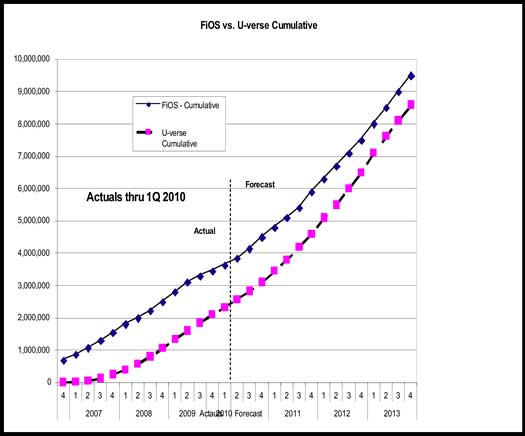 Woodstock Goes FTTH - Woodstock Telephone Company in Minnesota, that is. Delivering up to 75 Mb/s over a 450 square mile service area. (TellLabs) Residents of Ashby de la Launde, a small village in Lincolnshire, UK, will soon be able to install 100-Mbps fiber-optic broadband into their homes via the FTTH network. Lightwave. Nearly 60 homes and three businesses have started on-site digging to connect to the FTTH network to be installed around the village. The project involves the community working together to establish a privately funded network. New Report : FTTH connections continue to grow in North America You can download and read the entire report from the FTTH council website. http://www.ftthcouncil.org/sites/default/files/RVA.FTTH_.Apr10.040712Final.pdf Testing FTTH JDSU shows how to test a PON with an OTDR: http://www.jdsu.com/other-literature/PON-OTDR_fop_an_ae.pdf US FTTH Connections Continue To Grow 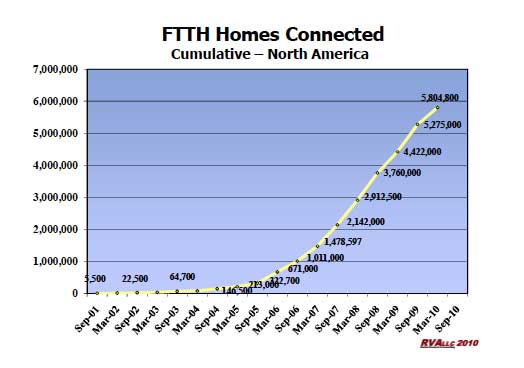 According to a just released FTTH Council Report prepared by RVA, FTTH connections continue to grow in North America - 99% of which are in the US, but growth seems to be slowing, probably a consequence of the current economy. Much of the FTTH deployment in the US has been due to Verizon's $23 billion investment in FTTH, but the report noted that FTTH is now being deployed by more than 750 service providers across North America. Most of these service providers are small, independent telephone companies that are replacing their copper lines with end-to-end fiber to ensure their future competitiveness as broadband providers. Of the service providers not yet offering FTTH, a majority say they are likely to soon. You can download and read the entire report from the FTTH council website. http://www.ftthcouncil.org/sites/default/files/RVA.FTTH_.Apr10.040712Final.pdf David Chaffee's FTTH Prism Newsletter is Online (archives are at bottom of the linked page)
|
What Is The FOA? Hear FOA President Jim Hayes tell the FOA Story in a 2-part interview by Sound & Video Contractor Contributing Editor Bennett Liles. It tells about the FOA history, goals and achievements. Part 1: http://svconline.com/podcasts/audio/fiber_optic_association_part1/index.html. Part 2 http://svconline.com/podcasts/audio/inside-fiber-optic-association2-0924/index.html. |
|
Digging Safely (Read the FOA Tech Topic) There is a new toll-free "call before you dig" number: 811 See www.call811.com for more information National Fiber Optic Protection Summit: By the "811" group. March, 2008 in Vegas.
|
|
|
New FOA Jobs Website We get many questions from CFOTs, students at FOA-Approved schools and others contemplating getting into the fiber optic business regarding jobs in fiber optics - and how to find them - so we’ve created a new web page to share some information we've gathered about jobs in our industry. The information is designed to help you understand what jobs are available in fiber optics, how to find them and apply for them. While the overall economy is pretty bad - you've probably heard that there are 5 times as many people unemployed in the US as there are jobs available, telecom is a bright spot - broadband is a major focus of stimulus spending in the US and countries around the world are building fiber networks as fast as possible. Even wireless companies have to build fiber for their backhaul. Cities are installing fiber linked surveillance cameras and smart traffic lights. Fiber is the link making Smart Grid possible. Companies like Allied Fiber are building large private networks. Telecom is one of the fastest growing businesses worldwide. If you are looking for a job in fiber optics, here is the FOA's guide to jobs. The FOA has created a group on A list of 10 ways to get your resume noticed from Marketplace on NPR Jobs Created As Part of Stimulus-Funded Projects The federal government is spending 7.2 billion dollars on the Broadband Technology Opportunities Program. This money is working it's way into the economy and hopefully will provide jobs. You can track recovery dollars and look for job opportunities on this website: www.recovery.gov Go to "opportinities" link then "jobs". You will see a section “find recovery jobs” – enter “fiber optic jobs California” or wherever you are and review what comes up. One of the projects funded by stimulus money is the1100 mile network of Maine Fiber Company Inc. which has selected nextGen Telecom Services Group Inc. as the installation contractor. CFOTs: NextGen has a link on their website for applying for jobs Techs For Project at Fort Hood, TX We need (4) four technicians in the Ft Hood area ( Jr to Mid level, Senior will work they fit into pay range) to work a project at FT Hood. This is a short term project ( maybe 2 weeks) and MUST began on Feb. 14th. Successful completion of this project could lead to long term employment and many projects. Technicians must have clean background and driving record and submit the following information directly to me at jburns@apsicorp.com. Full name : Drivers License number : Date Of Birth : Resume : * Ensure contact information is up to date James Burns, SBCA,CPCT/I,CFOT/I,CFOS/I EVP/CTO APSI & Mike Minter Consulting V: 704.944.3528 Office F: 888.259.6236 jburns@apsicorp.com www.apsicorp.com Training Tomorrows Fiber Optic, Solar And Satellite Technicians Outside Plant Designer to join a team in Calgary and Fort McMurray, Canada. (10/28/10) In this highly varied and technical role, you will design the implementation of network Infrastructure projects. You will be working with fibre and copper outside plant cabling and wireless systems. More specifically, your responsibilities will include: • Coordinating, consulting, and providing support on all voice and data cable plant jobs and projects; • Providing technical solutions to support business needs and providing troubleshooting on technical problems; • Coordinating the requirements for and delivery of Redlines, As-Built Drawings and work packages; • Working with drafting personnel to produce and maintain drawings depicting splicing, terminating, and patching information, circuit assignments, and floor plans wall layouts, equipment cabinets, tray layouts, other equipment etc. We are looking for a Journeyman Communication Technician who has substantial heavy industrial experience and is actively involved in network infrastructure design. Ideally you are a Registered Communications Distribution Designer (RCDD) with outside plant specialization. We are looking for individuals who have extensive field installation experience. Having experience with cable designs for large heavy industrial plant sites and large campus environments will ensure your success in this role. We are seeking applicants who have experience with aerial communications cabling design and splicing of fibre in an outside plant environment. About the Benefits In reward for your hard work and dedication, you will receive a highly competitive remuneration package depending on qualifications and experience. Our client understands employing the right people is vital to their ongoing success; therefore they offer them a wide range of excellent benefits including: • Cell phone for work purposes; • Comprehensive benefits package including medical, dental, and vision plan; • Two weeks minimum vacation; • Relocation assistance may be provided. Please Apply Online to the location of your choice: Fort McMurray, Alberta – http://www.applyfirst.ca/job19812 Calgary, Alberta – http://www.applyfirst.ca/job20899 Fiber Optic Engineer – Research and creative new product development wisdom (10/12/2010) Do you just love to peal back the onion of a fiber optic product and find out what really makes it work and are challenged to make it work better? Does your interest in fiber optics go to digging into the physics of optical communications? Are you excited about finding ways to make high speed data transport optical cable better? When it comes to the next generation of premise wire for data centers do you have the wisdom to help create the fiber systems that will become industry standards? Then this engineering research opportunity will be a utopia for your career in creative engineering design and development within a research lab where you can excel. We’re looking for an engineer who is turned-on by researching, designing, and developing passive optical communication products that are ahead of the curve in anticipating customers’ requirements in high data rate fiber optic communication systems including cables, connectors, panels, cords, and other infrastructure products for critical communications networks. The goal of this engineer will be to create new fiber optic products with superior reliability, performance, and scalability. The top candidate for this responsibility will have a history of creative R&D with multi or single mode fiber infrastructure products and have demonstrated a career of product development knowledge that has led to production sensitivities required in lean manufacturing. This position focuses on strategic and tactical design engineering leadership and NPD for fiber optic components that will complement the company’s expansive telecommunication network product lines. By developing its offerings ahead of the curve and anticipating customers’ requirements in high data rate fiber optic communication systems, this Chicagoland company will continue its expansion as a world-class technology leader. The person in this position will join this half-billion dollar company’s “go-to” research team for NPD and will interact with cross-functional groups that will include engineering, manufacturing, marketing, and sales. Some challenges will include: 1. Lead the research efforts of advanced fiber optic products from concept through the proof-of-principle, explore and research emerging applications/ technologies that enable new product opportunities, and evaluate performances of optical communication systems, interconnect technologies, and new emerging optical technologies – some into the GHz range. 2. Using experimental research design, build, and troubleshoot prototypes/concept models using optical principles and test methods that will validate theories and models. 3. Perform measurements and benchmark analysis on fiber optic components, prototypes and existing products to determine future product design requirements. 4. Develop new optical test methods for prototype, component or product evaluations. Experience being sought: 1. NPD engineering background – in fiber optic infrastructure which may include: communication systems, components including lasers, detectors, transceivers, and optical cable and connectors, assemblies, and adapters. 2. Experience working with lean manufacturing environments and methods. 3. Innovation career track record of providing creative solutions to complex problems. 4. College Degree in related engineering sciences which may include: Physics, Optical Science, Optoelectronics, Photonics. If you think you have the skills to join this company’s R&D research lab team for new fiber products and have the wisdom for advancement in NPD, call me. Challenge your career, and become an industry creative leader for fiber optic communication. Or -- if you know someone whose career might be ready for this level of enhancement, please feel comfortable passing this information to you network. Jack Bourque President 860-738-5035 ex: 23 www.WirelessCareers.com Do listings in the FOA Newsletter Work? Here's feedback: "We did great! We have over 15 interviews next week." "Your newsletter generated a significant number of applicants and we have filled the position." |
|
Each month we will award 5 copies of the FOA textbook of choice to the first 5 correct answers. January 2011 In the new FOA Lecture on Safety on YouTube, we discuss one type of fiber optic test instrument can increase the possibility of eye damage under some circumstances. What instrument is that? A. OTDR B. OLTS C. VFL D. Microscope
Your Name, CFOT® - It pays to advertise! The FOA encourages CFOTs to use the logo on their business cards, letterhead, truck or van, etc. and provides logo files on this site for that purpose. But we are also asked about how to use the CFOT or CFOS certifications. Easy, you can refer to yourself as "Your Name, CFOT" or "Your Name, CFOS/T" for example. Feel free to use the logo and designations to promote your achievements and professionalism! |
|
Remember To Renew Your Certification ! Remember
to renew your FOA certification. All current CFOTs have a ID Card with
their certification data and we keep a database of current CFOTs to
answer inquiries regarding your qualifications if needed. You must be a
current FOA member and CFOT to participate in our online
database of installers, contractors, technicians and consultants.
If you forgot to renew, use the online application
form to renew NOW! You can now renew your FOA certification online - and get an extra month free. Details here. |
|
|
November Under pulling tension, the bend radius of a fiber optic cable should not be less than ___________. A. 5 times the cable diameter B. 10 times the cable diameter C. 20 times the cable diameter D. 50 times the cable diameter See the FOA Reference Guide for more info. Gt (C)1999-2010, The Fiber Optic Association, Inc. |